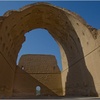Disclaimer
This entry contains information known to us from a variety of sources but may not include all the information currently available. Please be in touch if you notice any inadvertent mistakes in our presentation or have additional knowledge or sources to share. Thank you.
Archive
Salman Pak Site of the Exilarch at Baghdad, Iraq
The Salman Pak Site of the Exilarch at Baghdad reflects the history of the Jewish Exilarchs--leaders of the exiled Babylonian Jews--in Iraq and Persia. The Salman Pak Site of the Exilarch is situated within the town of Mahoza, also known as Salman Pak or al-Mada'in. As early as the first century, Mahoza was believed to have been inhabited by the Iranian Parthava (Parthians) where the site of Ctesiphon served as the Sassanian empire's winter capital [1]. Historically, Mahoza was believed to have supported a primarily Jewish community as early as the third century. However, in 363C.E., the town was destroyed by Roman forces under the leadership of Julian the Apostate. When Mahoza was eventually rebuilt, it was governed by the Jewish Prince of the Captivity [2]. In 495, Mar Zutra II, the Jewish Exilarch of Mahoza, led a revolt against Persia which created seven years of political independence [3]. However, this independence came to an end when the Persian King Kobad executed both Mar Zutra and his grandfather Mar Hanina on the bridge of Mahoza, and took most of Mahoza's Jews captive around the year 520 [4]. On the same day that Mar Zutra II was killed, his son Mar Zutra III was born. In light of the Persian attack, most of Mar Zutra's family--including his son--fled Mahoza for Israel [5].
Description
Salman Pak: Salman Pak is named after the Jewish hero Shallum (also known as Salmaan Farsi). In 628, Heraclius had killed the Persian King Khosrau, leading to a succession of nine different kings who fought for the remains of the royal position. At this point, Shallum noted the threat that this chaos posed to Babylonian Jews, pariticularly those in Mahoza. As such, in 633 Shallum traveled with Al-Muthanna, a member of the Bekr tribe, along the Persian Gulf. Although Al-Muthanna and his men killed many, they never attacked Jewish peasants. Shallum and Al-Muthanna eventually came to work alongside Abu Bakr, who died in 634. Abu Bakr's successor, 'Umar, placed Shallum in command of his troops. Now in a position of leadership, Shallum (whose brother was an Exilarch who had been betrayed by Persians) fought against the Sassanian Dynasty. To achieve this, Shallum adapted the teachings of the Prophet Muhammad to create a universal religion for both Jews and Persians. Shallum also supported Jewish academies, translated the Qur'an into Persian, defeated the Persian army at the battle of Qadisiya in 637, and eventually occupied all of Iraq. At this point, Shallum established his capital in the city which once served as the ancient site of the Exilarch--Mahoza. Although Shallum was regarded as a traitor by many Iranians, he was viewed as a hero by Arabs and Jews. When he eventually died, Shallum was buried in Mahoza--today named Salman Pak in honor of him [6]
Baghdad: Baghdad was home to the largest Jewish community in Iraq possibly from as early as its founding in the eighth century. By 1908, the Jews of Baghdad numbered around 53,000, about a third of Baghdad's total population, and lived in many quarters--including al-Tawrat, Tahat it-Takyah, Abu Saifan, and Suq Hannun. Although Jews were involved in local politics, new tensions began to rise between Jews and Muslims--leading to an anti-Jewish riot on October 15, 1908--and World War I forced many Jews to flee the city. In 1948, the Jewish community in Baghdad numbered around 77,000; however, the Jewish community began to fear life in Baghdad after the Farhūd, a pogrom which occured on June 1, 1941, left 130 Jews killed and millions lost in property damange. The Farhūd inspired the growth of Zionism and Communism among a minority of Jews in Baghdad who felt increasingly disconnected from the Iraq state. Bombings throughout the 1950s further estranged the Jewish community, and by 1952 only about 6,000 Jews remained in Iraq. The Jewish community endured further violence throughout Saddam Husayn's regime, and by 2003 the last synagogue in Baghdad had closed [7].
Sources
[1] "The Persian-Zoroastrian Connection - Salman Parsi / Farsi (568-644 CE)," Zoroastrian Heritage, 2005-2014, accessed August 7, 2014, http://www.heritageinstitute.com/zoroastrianism/history/islamichistory1.htm.
[2] "MAḤOZA (, i.e., "The City")," JewishEncyclopedia.com, 2002-2011, accessed August 7, 2014, http://www.jewishencyclopedia.com/articles/10292-mahoza.
[3] Geoffrey Herman, A Prince Without a Kingdom: The Exilarch in the Sasanian Era (Tubingen: Mohr Siebeck, 2012), p. 295, accessed August 5, 2014, http://books.google.com/books?id=h2q_Q-34GgkC&printsec.
[4] "MAḤOZA (, i.e., "The City")."
[5] Herman, A Prince Without a Kingdom, p. 295.
[6] "The Conquest of Persia and Shallum's Return," The Committee for Historical Research in Islam and Judaism, 2004-2012, accessed August 5, 2014, http://www.alsadiqin.org/en/index.php?title=The_Conquest_of_Persia_and_Shallum%27s_Return.
[7] Yaron Ayalon; Ariel I. Ahram, "Baghdad," Encyclopedia of Jews in the Islamic World, Executive Editor Norman A. Stillman, Brill Online, 2014, Reference, Wellesley College, 24 June 2014 <http://referenceworks.brillonline.com/entries/encyclopedia-of-jews-in-the-islamic-world/baghdad-SIM_000468>.
Photos
Fukada, Shiho. "The Ctesiphon Arch in Salman Pak, south of Baghdad." The New York Times. January 2, 2011. Accessed Augst 7, 2014, http://atwar.blogs.nytimes.com/2011/01/02/a-tour-of-iraqs-ancient-sites/?_php=true&_type=blogs&_php=true&_type=blogs&_r=1.
IPC. "The Salman Farsi Mosque at Mada'in / Salman Pak." Zoroastrian Heritage. 2005-2014. Accessed August 7, 2014, http://www.heritageinstitute.com/zoroastrianism/history/islamichistory1.htm.
IPC. "The Salman Farsi Shrine at Mada'in / Salman Pak." Zoroastrian Heritage. 2005-2014. Accessed August 7, 2014, http://www.heritageinstitute.com/zoroastrianism/history/islamichistory1.htm.
Wikipedia. "The Remaining arch and walls of the palace at Ctesiphon/Mada'in/Salman Pak." Zoroastrian Heritage. 2005-2014. Accessed August 7, 2014, http://www.heritageinstitute.com/zoroastrianism/history/islamichistory1.htm.



